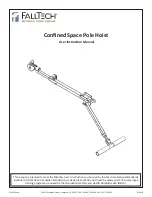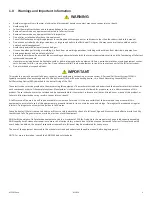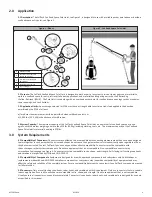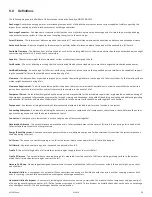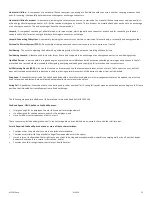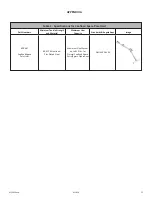
9.0 Definitions
The following are general definitions of fall protection terms as defined by ANSI Z359.0-2012.
Anchorage -
A secure connecting point or a terminating component of a fall protection system or rescue system capable of safely supporting the
impact forces applied by a fall protection system or anchorage subsystem.
Anchorage Connector -
A component or subsystem that functions as an interface between the anchorage and a fall protection, work positioning,
rope access or rescue system for the purpose of coupling the system to the anchorage.
Arrest Distance -
The total vertical distance required to arrest a fall. The arrest distance includes the deceleration distance and activation distance.
Authorized Person –
A person assigned by the employer to perform duties at a location where the person will be exposed to a fall hazard.
Available Clearance -
The distance from a reference point, such as the working platform, to the nearest obstruction that an authorized person might
contact during a fall which, if struck, could cause injury.
Capacity -
The maximum weight that a component, system or subsystem is designed to hold.
Certification -
The act of attesting in writing that the criteria established by these standards or some other designated standard have been met.
Certified Anchorage -
An anchorage for fall arrest, positioning, restraint or rescue systems that a qualified person certifies to be capable of support-
ing the potential fall forces that could be encountered during a fall.
Clearance -
The distance from a specified reference point, such as the working platform or anchorage of a fall arrest system, to the lower level that a
worker might encounter during a fall.
Clearance Requirement -
The distance below an authorized person that must remain clear of obstructions in order to ensure that the authorized
person does not make contact with any objects that would cause injury in the event of a fall.
Competent Person -
An individual designated by the employer to be responsible for the immediate supervision, implementation and monitoring of
the employer’s managed fall protection program who, through training and knowledge, is capable of identifying, evaluating and addressing existing
and potential fall hazards, and who has the employer’s authority to take prompt corrective action with regard to such hazards.
Component -
An element or integral assembly of interconnected elements intended to perform one function in the system.
Connecting Subsystem -
An assembly, including the necessary connectors, comprised of all components, subsystems, or both, between the anchor-
age or anchorage connector and the harness attachment point.
Connector -
A component or element that is used to couple parts of the system together.
Deceleration Distance -
The vertical distance between the user’s fall arrest attachment at the onset of fall arrest forces during a fall, and after the
fall arrest attachment comes to a complete stop.
Energy (Shock) Absorber -
A component whose primary function is to dissipate energy and limit deceleration forces which the system imposes on
the body during fall arrest.
Fall Arrest -
The action or event of stopping a free fall or the instant where the downward free fall has been stopped.
Fall Hazard -
Any location where a person is exposed to a potential free fall.
Free Fall -
The act of falling before a fall protection system begins to apply forces to arrest the fall.
Free Fall Distance -
The vertical distance traveled during a fall, measured from the onset of a fall from a walking working surface to the point at
which the fall protection system begins to arrest the fall.
Harness, Full Body -
A body support designed to contain the torso and distribute the fall arrest forces over at least the upper thighs, pelvis, chest
and shoulders.
Horizontal Lifeline –
A component of a horizontal lifeline subsystem, consisting of a flexible line with connectors or other coupling means at both
ends for securing it horizontally between two anchorages or anchorage connectors.
Horizontal Lifeline Subsystem –
An assembly, including the necessary connectors, comprised of a horizontal lifeline component and, optionally, of:
a) An energy absorbing component or, b) A lifeline tensioner component, or both. This subsystem is normally attached at each end to an anchorage
or anchorage connector. The end anchorages have the same elevation.
011819
MCS41 Rev A
10

